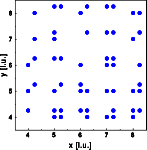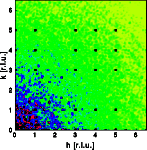Diffuse scattering: Occupational disorder I

Diffuse scattering
Thermal I
Thermal II
Occupational I
Occupational II
Longitudinal waves
Transversal waves
Short range order
Stacking faults
Interactive examples
Displacement waves
Short range order
Stacking faults
Goto
Contents


The Bragg reflections are shown as black dots, most of them are overexposed. Diffuse scattering results that is essentially monotonous in reciprocal space. Note that now the diffuse scattering is more intense at shorter reciprocal vectors h a typical phenomenon of replacement disorder. Lets look again at the formula from the first example:

Now u - < u > is zero for all atoms. The term (f - < f > ) is largest near the center of reciprocal space and diminishes with the diminishing value of < f >. Note that this relationship holds only for X-ray diffraction! Since the scattering length f for neutron scattering is independent of the absolute value of h, the random replacement diffuse neutron scattering is independent of the location in reciprocal space.